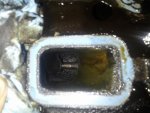warmachine5500
Well-Known Member
- Joined
- Nov 19, 2008
- Messages
- 47
- Vehicle Year
- 1994
- Transmission
- Automatic
94 4.0 Ranger. I used to own this truck but I gave it to my uncle a few years ago. He's 67 years old and doesn't beat on the truck at all. It never had this problem when I owned it.
The ranger ran great for a long time, but developed a misfire on cylinder 3. Upon pulling the plug I could see that it was all fouled up with black gunky stuff. It just smelled like oil, but it was hard (not soft and mushy). I wasn't sure what it was. All the other plugs looked great. I did a compression test, and the results were good.
Cyl 1: 183 psi
Cyl 2: 168 psi
Cyl 3: 183 psi
Cyl 4: 180 psi
Cyl 5: 181 psi
Cyl 6: 172 psi
I replaced the plug, but it began fouling up quickly (within 100 miles). The plug doesn't smell like gas, so I thought maybe there was a bad fuel injector. I put a long screwdriver on the injectors and I could hear them all clicking, but I suppose it's possible the number 3 injector is clogged. All cylinders ARE getting spark. I confirmed that with an inline spark tester. Cyl 3 isn't firing at all, even with the new plug (I pulled the wires off the coil pack while it was running and cyl 3 is the only one that doesn't change the idle). I don't know how long my uncle was driving the truck with this dead miss on cyl 3, so I'm wondering what kind of damage driving with that misfire could cause? I don't see any oil in the coolant, or coolant in the oil. Both look, smell, and feel normal.
So I pulled off the upper intake manifold with the intention of changing the fuel injector and I see what I believe to be coolant in the upper intake manifold port. See attached files for pictures. The other intake ports look black and 21 years old, but normal. Then I pulled off the fuel rail and lower intake manifold. You can see coolant in the lower intake manifold in the cylinder 3 port. Most of the gasket came off the lower manifold and onto the top of the motor. The gasket around ALL of the coolant ports looks kinda crappy to me, but the gasket around all of the intake ports themselves looks to be ok.
I also took picture of the bottom of the lower intake manifold. You can see how the bottom of the manifold looks different around the cyl 3 port. It looks as if some of the coolant is stuck to the bottom of the manifold as well. But that's only around the cyl 3 port. The bottom of the manifold looks normal around all the other ports. So perhaps the lower intake manifold gasket was simply leaking around cyl 3, and the coolant made its way in there?
Are these 4.0 intake manifolds known for cracking? I haven't found any cracks yet. I'm hoping the lower intake manifold gasket was simply leaking around those coolant ports. I realize I could also have a cracked head or head gasket. It puzzles me as to how this coolant would have gone UP the intake manifold instead of just down into the oil. Could my uncle have done severe damage by driving with this misfire? He hasn't reported any overheating.
Thanks for any help guys. I'm debating as to whether or not I want to take off the heads and keep investigating, or just try throwing a new gasket on the manifold here and putting it back together. I'm interested in all input!
The ranger ran great for a long time, but developed a misfire on cylinder 3. Upon pulling the plug I could see that it was all fouled up with black gunky stuff. It just smelled like oil, but it was hard (not soft and mushy). I wasn't sure what it was. All the other plugs looked great. I did a compression test, and the results were good.
Cyl 1: 183 psi
Cyl 2: 168 psi
Cyl 3: 183 psi
Cyl 4: 180 psi
Cyl 5: 181 psi
Cyl 6: 172 psi
I replaced the plug, but it began fouling up quickly (within 100 miles). The plug doesn't smell like gas, so I thought maybe there was a bad fuel injector. I put a long screwdriver on the injectors and I could hear them all clicking, but I suppose it's possible the number 3 injector is clogged. All cylinders ARE getting spark. I confirmed that with an inline spark tester. Cyl 3 isn't firing at all, even with the new plug (I pulled the wires off the coil pack while it was running and cyl 3 is the only one that doesn't change the idle). I don't know how long my uncle was driving the truck with this dead miss on cyl 3, so I'm wondering what kind of damage driving with that misfire could cause? I don't see any oil in the coolant, or coolant in the oil. Both look, smell, and feel normal.
So I pulled off the upper intake manifold with the intention of changing the fuel injector and I see what I believe to be coolant in the upper intake manifold port. See attached files for pictures. The other intake ports look black and 21 years old, but normal. Then I pulled off the fuel rail and lower intake manifold. You can see coolant in the lower intake manifold in the cylinder 3 port. Most of the gasket came off the lower manifold and onto the top of the motor. The gasket around ALL of the coolant ports looks kinda crappy to me, but the gasket around all of the intake ports themselves looks to be ok.
I also took picture of the bottom of the lower intake manifold. You can see how the bottom of the manifold looks different around the cyl 3 port. It looks as if some of the coolant is stuck to the bottom of the manifold as well. But that's only around the cyl 3 port. The bottom of the manifold looks normal around all the other ports. So perhaps the lower intake manifold gasket was simply leaking around cyl 3, and the coolant made its way in there?
Are these 4.0 intake manifolds known for cracking? I haven't found any cracks yet. I'm hoping the lower intake manifold gasket was simply leaking around those coolant ports. I realize I could also have a cracked head or head gasket. It puzzles me as to how this coolant would have gone UP the intake manifold instead of just down into the oil. Could my uncle have done severe damage by driving with this misfire? He hasn't reported any overheating.
Thanks for any help guys. I'm debating as to whether or not I want to take off the heads and keep investigating, or just try throwing a new gasket on the manifold here and putting it back together. I'm interested in all input!
Attachments
-
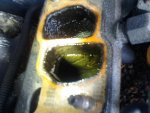 coolant in intake 2.jpg61.5 KB · Views: 163
coolant in intake 2.jpg61.5 KB · Views: 163 -
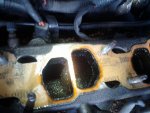 normal intake.jpg69.5 KB · Views: 137
normal intake.jpg69.5 KB · Views: 137 -
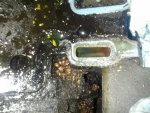 front driver coolant port.jpg94.4 KB · Views: 156
front driver coolant port.jpg94.4 KB · Views: 156 -
 front passenger coolant port.jpg67.9 KB · Views: 145
front passenger coolant port.jpg67.9 KB · Views: 145 -
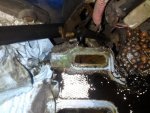 rear passenger coolant port.jpg76.9 KB · Views: 143
rear passenger coolant port.jpg76.9 KB · Views: 143 -
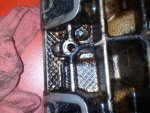 bottom of intake, normal.jpg87.1 KB · Views: 153
bottom of intake, normal.jpg87.1 KB · Views: 153 -
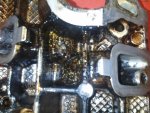 bottom of intake, cyl 3.jpg89.9 KB · Views: 148
bottom of intake, cyl 3.jpg89.9 KB · Views: 148 -
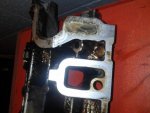 bottom of intake, cyl 3 port.jpg64.9 KB · Views: 151
bottom of intake, cyl 3 port.jpg64.9 KB · Views: 151 -
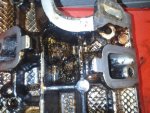 surrounding cyl 3 bottom of intake.jpg96.4 KB · Views: 155
surrounding cyl 3 bottom of intake.jpg96.4 KB · Views: 155 -
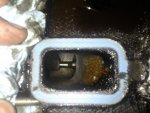 normal intake port, top of block.jpg62 KB · Views: 148
normal intake port, top of block.jpg62 KB · Views: 148

